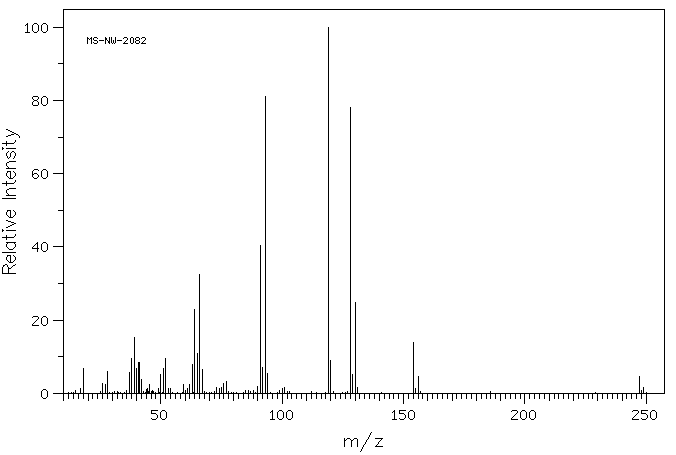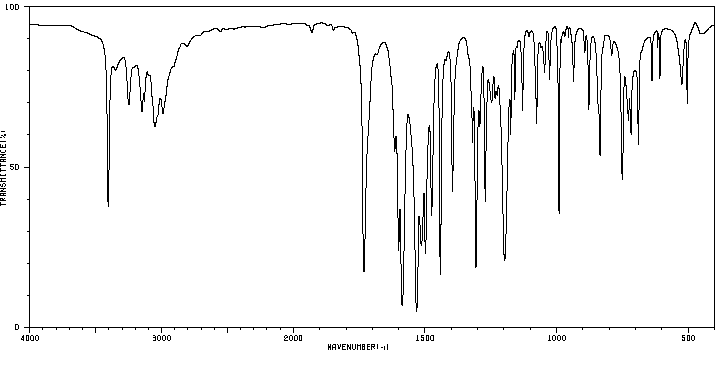氯吡脲 | 68157-60-8
-
物化性质
-
计算性质
-
ADMET
-
安全信息
-
SDS
-
制备方法与用途
-
上下游信息
-
文献信息
-
表征谱图
-
同类化合物
-
相关功能分类
-
相关结构分类
物化性质
-
熔点:170-172°C
-
沸点:308.4±27.0 °C(Predicted)
-
密度:1.415±0.06 g/cm3(Predicted)
-
溶解度:溶于DMSO或乙醇
-
颜色/状态:White to off-white crystalline powder
-
闪点:FLASH POINT, °F: >200 Pensky Martin Closed Cup /Kim Blue Plant Growth Regulator/
-
蒸汽压力:3.45X10-10 mm Hg at 25 °C (gas saturation method)
-
稳定性/保质期:
远离氧化物,兔皮肤接触会有轻微刺激性。Ames试验和微核试验结果显示,该物质无致突变作用。
-
分解:Carbon monoxide and carbon dioxide from burning. /Kim Blue Plant Growth Regulator/
-
解离常数:pKa1 = 2.5; pKa2 = 12.25
计算性质
-
辛醇/水分配系数(LogP):2.4
-
重原子数:17
-
可旋转键数:2
-
环数:2.0
-
sp3杂化的碳原子比例:0.0
-
拓扑面积:54
-
氢给体数:2
-
氢受体数:2
ADMET
安全信息
-
危险等级:9
-
危险品标志:Xi
-
安全说明:S26,S36
-
危险类别码:R36/37
-
WGK Germany:3
-
海关编码:2933399090
-
危险品运输编号:UN3077 9/PG 3
-
RTECS号:YS7182500
-
储存条件:存放在密封容器中,并放置在阴凉、干燥处。请将储存地点远离氧化剂。适宜在2-8 ºC下保存。
SDS
模块 1. 化学品
1.1 产品标识符
: N-(2-氯-4-吡啶基)-N′-苯基脲
产品名称
1.2 鉴别的其他方法
CPPU
4-CPPU
1.3 有关的确定了的物质或混合物的用途和建议不适合的用途
仅用于研发。不作为药品、家庭或其它用途。
模块 2. 危险性概述
2.1 GHS-分类
急性毒性, 经口 (类别 4)
急性水生毒性 (类别 2)
2.2 GHS 标记要素,包括预防性的陈述
象形图
警示词 警告
危险申明
H302 吞咽有害。
H401 对水生生物有毒。
警告申明
预防措施
P264 操作后彻底清洁皮肤。
P270 使用本产品时不要进食、饮水或吸烟。
P273 避免释放到环境中。
事故响应
P301 + P312 如果吞咽并觉不适: 立即呼叫解毒中心或就医。
P330 漱口。
废弃处置
P501 将内容物/ 容器处理到得到批准的废物处理厂。
当心 - 物质尚未完全测试。
2.3 其它危害物 - 无
模块 3. 成分/组成信息
3.1 物 质
: CPPU
别名
4-CPPU
: C12H10ClN3O
分子式
: 247.68 g/mol
分子量
组分 浓度或浓度范围
Urea, N-(2-chloro-4-pyridinyl)-N'-phenyl-
<=100%
化学文摘登记号(CAS 68157-60-8
No.)
模块 4. 急救措施
4.1 必要的急救措施描述
一般的建议
请教医生。 向到现场的医生出示此安全技术说明书。
吸入
如果吸入,请将患者移到新鲜空气处。 如呼吸停止,进行人工呼吸。 请教医生。
皮肤接触
用肥皂和大量的水冲洗。 请教医生。
眼睛接触
用水冲洗眼睛作为预防措施。
食入
切勿给失去知觉者通过口喂任何东西。 用水漱口。 请教医生。
4.2 主要症状和影响,急性和迟发效应
据我们所知,此化学,物理和毒性性质尚未经完整的研究。
4.3 及时的医疗处理和所需的特殊处理的说明和指示
无数据资料
模块 5. 消防措施
5.1 灭火介质
灭火方法及灭火剂
用水雾,抗乙醇泡沫,干粉或二氧化碳灭火。
5.2 源于此物质或混合物的特别的危害
碳氧化物, 氮氧化物, 氯化氢气体
5.3 给消防员的建议
如必要的话,戴自给式呼吸器去救火。
5.4 进一步信息
无数据资料
模块 6. 泄露应急处理
6.1 作业人员防护措施、防护装备和应急处置程序
使用个人防护用品。 避免粉尘生成。 避免吸入蒸气、烟雾或气体。 保证充分的通风。 避免吸入粉尘。
6.2 环境保护措施
如能确保安全,可采取措施防止进一步的泄漏或溢出。 不要让产品进入下水道。
一定要避免排放到周围环境中。
6.3 泄漏化学品的收容、清除方法及所使用的处置材料
收集和处置时不要产生粉尘。 扫掉和铲掉。 放入合适的封闭的容器中待处理。
6.4 参考其他部分
丢弃处理请参阅第13节。
模块 7. 操作处置与储存
7.1 安全操作的注意事项
避免接触皮肤和眼睛。 避免形成粉尘和气溶胶。
在有粉尘生成的地方,提供合适的排风设备。
7.2 安全储存的条件,包括任何不兼容性
贮存在阴凉处。 使容器保持密闭,储存在干燥通风处。
建议的贮存温度: 2 - 8 °C
7.3 特定用途
无数据资料
模块 8. 接触控制和个体防护
8.1 容许浓度
最高容许浓度
没有已知的国家规定的暴露极限。
8.2 暴露控制
适当的技术控制
根据良好的工业卫生和安全规范进行操作。 休息前和工作结束时洗手。
个体防护设备
眼/面保护
带有防护边罩的安全眼镜符合 EN166要求请使用经官方标准如NIOSH (美国) 或 EN 166(欧盟)
检测与批准的设备防护眼部。
皮肤保护
戴手套取 手套在使用前必须受检查。
请使用合适的方法脱除手套(不要接触手套外部表面),避免任何皮肤部位接触此产品.
使用后请将被污染过的手套根据相关法律法规和有效的实验室规章程序谨慎处理. 请清洗并吹干双手
所选择的保护手套必须符合EU的89/686/EEC规定和从它衍生出来的EN 376标准。
身体保护
全套防化学试剂工作服, 防护设备的类型必须根据特定工作场所中的危险物的浓度和数量来选择。
呼吸系统防护
如须暴露于有害环境中,请使用P95型(美国)或P1型(欧盟 英国
143)防微粒呼吸器。如需更高级别防护,请使用OV/AG/P99型(美国)或ABEK-P2型 (欧盟 英国 143)
防毒罐。
呼吸器使用经过测试并通过政府标准如NIOSH(US)或CEN(EU)的呼吸器和零件。
模块 9. 理化特性
9.1 基本的理化特性的信息
a) 外观与性状
形状: 结晶
颜色: 白色
b) 气味
无数据资料
c) 气味阈值
无数据资料
d) pH值
无数据资料
e) 熔点/凝固点
165 - 170 °C
f) 沸点、初沸点和沸程
无数据资料
g) 闪点
无数据资料
h) 蒸发速率
无数据资料
i) 易燃性(固体,气体)
无数据资料
j) 高的/低的燃烧性或爆炸性限度 无数据资料
k) 蒸气压
4.6 hPa 在 25 °C
l) 蒸汽密度
无数据资料
m) 密度/相对密度
无数据资料
n) 水溶性
0.039 g/l 在 21 °C
o) n-辛醇/水分配系数
辛醇--水的分配系数的对数值: 3.2 在 20 °C
p) 自燃温度
无数据资料
q) 分解温度
无数据资料
r) 粘度
无数据资料
模块 10. 稳定性和反应活性
10.1 反应性
无数据资料
10.2 稳定性
无数据资料
10.3 危险反应
无数据资料
10.4 应避免的条件
无数据资料
10.5 不相容的物质
强氧化剂
10.6 危险的分解产物
其它分解产物 - 无数据资料
模块 11. 毒理学资料
11.1 毒理学影响的信息
急性毒性
半数致死剂量 (LD50) 经口 - 大鼠 - 雄性 - 2,787 mg/kg
半数致死剂量 (LD50) 经口 - 大鼠 - 雌性 - 1,568 mg/kg
半数致死剂量 (LD50) 经口 - 小鼠 - 雄性 - 2,218 mg/kg
半数致死剂量 (LD50) 经口 - 小鼠 - 雌性 - 2,783 mg/kg
吸入: 在可达到的最大浓度下,半数致死量(LC50)/吸入/4小时/大鼠不能确定,因未观察到大鼠的死亡率。
皮肤刺激或腐蚀
眼睛刺激或腐蚀
轻度的眼睛刺激
无数据资料
呼吸道或皮肤过敏
无数据资料
生殖细胞致突变性
细胞突变性-体外试验 - Ames 试验(艾姆斯试验) - 鼠伤寒沙门氏菌 - 阳性
致癌性
IARC:
此产品中没有大于或等于 0。1%含量的组分被 IARC鉴别为可能的或肯定的人类致癌物。
生殖毒性
无数据资料
特异性靶器官系统毒性(一次接触)
无数据资料
特异性靶器官系统毒性(反复接触)
无数据资料
吸入危险
无数据资料
潜在的健康影响
吸入 吸入可能有害。 可能引起呼吸道刺激。
摄入 误吞对人体有害。
皮肤 通过皮肤吸收可能有害。 可能引起皮肤刺激。
眼睛 可能引起眼睛刺激。
接触后的征兆和症状
据我们所知,此化学,物理和毒性性质尚未经完整的研究。
附加说明
反复染毒毒性 - 大鼠 - 经口 - 未观察到有害效果的水平 - 7.5 mg/kg
化学物质毒性作用登记: 无数据资料
模块 12. 生态学资料
12.1 生态毒性
对鱼类的毒性 半数致死浓度(LC50) - 虹鳟 (红鳟鱼) - 9.2 mg/l
半数致死浓度(LC50) - 鲫鱼(金鱼) - 10 - 40 mg/l
半数致死浓度(LC50) - 鲫属 (鲤鱼) - 8.6 mg/l
对水蚤和其他水生无脊 半数致死浓度(LC50) - 水蚤 - 8.0 mg/l
椎动物的毒性
对藻类的毒性 半数有效浓度(以生物量计)(EbC50) - Pseudokirchneriella subcapitata -
3.3 mg/l
12.2 持久性和降解性
无数据资料
12.3 潜在的生物累积性
无数据资料
12.4 土壤中的迁移性
无数据资料
12.5 PBT 和 vPvB的结果评价
无数据资料
12.6 其它不良影响
对水生生物有毒。
模块 13. 废弃处置
13.1 废物处理方法
产品
将剩余的和不可回收的溶液交给有许可证的公司处理。
与易燃溶剂相溶或者相混合,在备有燃烧后处理和洗刷作用的化学焚化炉中燃烧
受污染的容器和包装
按未用产品处置。
模块 14. 运输信息
14.1 联合国危险货物编号
欧洲陆运危规: 3077 国际海运危规: 3077 国际空运危规: 3077
14.2 联合国运输名称
欧洲陆运危规: ENVIRONMENTALLY HAZARDOUS SUBSTANCE, SOLID, N.O.S. (Urea, N-(2-chloro-4-
pyridinyl)-N'-phenyl-)
国际海运危规: ENVIRONMENTALLY HAZARDOUS SUBSTANCE, SOLID, N.O.S. (Urea, N-(2-chloro-4-
pyridinyl)-N'-phenyl-)
国际空运危规: EnvironmeNTAlly hazardous subSTance, solid, n.o.s. (Urea, N-(2-chloro-4-pyridinyl)-N'-
phenyl-)
14.3 运输危险类别
欧洲陆运危规: 9 国际海运危规: 9 国际空运危规: 9
14.4 包裹组
欧洲陆运危规: III 国际海运危规: III 国际空运危规: III
14.5 环境危险
欧洲陆运危规: 是 国际海运危规 国际空运危规: 是
海洋污染物(是/否): 是
14.6 对使用者的特别提醒
进一步信息
危险品独立包装,液体5升以上或固体5公斤以上,每个独立包装外和独立内包装合并后的外包装上都必须有EHS
标识 (根据欧洲 ADR 法规 2.2.9.1.10, IMDG 法规 2.10.3),
若适用,该化学品满足《危险化学品安全管理条例》(2002年1月9号国务院通过)的要求。
模块 16. 其他信息
进一步信息
上述信息视为正确,但不包含所有的信息,仅作为指引使用。本文件中的信息是基于我们目前所知,就正
确的安全提示来说适用于本品。该信息不代表对此产品性质的保证。
参见发票或包装条的反面。
模块 15 - 法规信息
N/A
制备方法与用途
氯吡苯脲(1-(2-氯吡啶-4-基)-3-苯基脲,简称CPPU),又称氯吡脲、KT-30等,是一种细胞分裂素类的植物生长调节剂。在采前使用时,它可以诱导愈伤组织生长,促进芽的发育;而在采后,则对控制多种果蔬叶片黄化和病害具有显著效果,例如延缓菜心、水稻叶片等的黄化。
毒性氯吡苯脲原药对小鼠急性经口毒性为LD₅₀ > 1510 mg/kg,大鼠急性经皮毒性为 LD₅₀ > 10000 mg/kg。它对兔皮肤有轻度刺激作用。Ames试验和微核试验显示无致突变作用。
作用机理氯吡苯脲是一种新型植物生长调节剂,具有高活性的苯脲类细胞分裂素物质。它可以促进植物生长、早熟,并延缓作物后期叶片的衰老,从而增加产量。
化学性质原药(含量85%以上)为白色固体粉末,熔点168~174℃。易溶于丙酮、乙醇和二甲基亚砜,在水中溶解度为65 mg/L。
用途氯吡苯脲是一种苯脲类细胞分裂素植物生长调节剂,具有促进芽的发育、加速细胞有丝分裂、促进细胞增大和分化、防止果实和花脱落等多种功能。主要表现在:①促进茎、叶、根、果生长;如用于烟草种植可使叶片肥大而增产。②促进结果,增加西红柿(番茄)、茄子、苹果等水果和蔬菜的产量。③加速疏果和落叶作用,提高果实品质并使果实大小均匀。对棉花和大豆而言,落叶可使收获更易进行。④浓度高时可作除草剂。⑤其他用途如:棉花的干枯作用、甜菜和甘蔗增加糖分等。
生物活性氯吡苯脲是一种具有细胞分裂素活性的苯脲类植物生长调节剂,其生物活性比6-苄氨基嘌呤高10-100倍。广泛用于农业、园艺和果树中,促进细胞分裂、扩大伸长,促进果实肥大;提高产量;保鲜等。
生产方法 方法一2-氯-4-氨基吡啶的制备:以2-氯吡啶为原料,在醋酸介质中用过氧化氢作氧化剂,氧化成2-氯吡啶-N-氧化物,混酸硝化得2-氯-4-硝基吡啶-N-氧化物,再通过常规方法还原得2-氯-4-氨基吡啶。另一种制备途径是:以异烟酸为原料,用过氧化氢氧化生成异烟酸N-氧化物,经胺化制得异烟酰胺N-氧化物,再氯化生成2-氯-异烟酰胺,最后通过霍夫曼降解反应生成2-氯-4-氨基吡啶。
方法二 方法三反应信息
-
作为反应物:参考文献:名称:1,3,5-Triazine-2-one derivatives and their use as plant growth regulators摘要:本申请公开了化合物3-(2-氯吡啶-4-基)-5-甲基-1-苯基-1,3,5-三嗪-2-酮。该化合物可用于增加葡萄的大小,作为棉花脱叶剂和除草剂。公开号:US04826526A1
-
作为产物:描述:2-氯-4-氨基吡啶 、 异氰酸苯酯 在 alumina 、 acetone-ether 作用下, 以 丙酮 为溶剂, 反应 8.0h, 以of N-(2-chloro-4-pyridyl)-N'-phenylurea is obtained的产率得到氯吡脲参考文献:名称:N-(2-Chloro-4-pyridyl)ureas摘要:公开了由式(I)表示的N-(2-氯-4-吡啶基)脲类化合物:##STR1## 其中R.sub.1代表氢或烷基,R.sub.2代表芳香基,尤其是苯基,可以被烷基,烷氧基,羟基或卤素取代,X为氧或硫,并公开了它们的酸加成盐,作为植物生长调节剂。还公开了制备和使用它们以及它们的农业组成物。公开号:US04193788A1
文献信息
-
[EN] ACC INHIBITORS AND USES THEREOF<br/>[FR] INHIBITEURS DE L'ACC ET UTILISATIONS ASSOCIÉES
-
[EN] BICYCLYL-SUBSTITUTED ISOTHIAZOLINE COMPOUNDS<br/>[FR] COMPOSÉS ISOTHIAZOLINE SUBSTITUÉS PAR UN BICYCLYLE申请人:BASF SE公开号:WO2014206910A1公开(公告)日:2014-12-31The present invention relates to bicyclyl-substituted isothiazoline compounds of formula (I) wherein the variables are as defined in the claims and description. The compounds are useful for combating or controlling invertebrate pests, in particular arthropod pests and nematodes. The invention also relates to a method for controlling invertebrate pests by using these compounds and to plant propagation material and to an agricultural and a veterinary composition comprising said compounds.本发明涉及公式(I)中变量如索权和说明中所定义的自行车基取代异噻唑啉化合物。这些化合物对抗或控制无脊椎动物害虫,特别是节肢动物害虫和线虫方面具有用途。该发明还涉及一种通过使用这些化合物来控制无脊椎动物害虫的方法,以及包含所述化合物的植物繁殖材料、农业和兽医组合物。
-
TETRAZOLINONE COMPOUND AND USE OF SAME申请人:SUMITOMO CHEMICAL COMPANY, LIMITED公开号:US20160081339A1公开(公告)日:2016-03-24A tetrazolinone compound of formula (1): wherein R 1 and R 2 each independently represents a hydrogen atom, etc.; R 3 represents a C1-C6 alkyl group, etc.; R 4 , R 5 , and R 6 each independently represents a hydrogen atom, etc.; A represents a C6-C16 aryl group optionally having one or more atoms or groups selected from Group P, etc.; Q represents the following group Q1, etc.; and X represents an oxygen atom or a sulfur atom, has excellent control activity against pests.
-
TRIAZOLE ACC INHIBITORS AND USES THEREOF
-
Molecules having pesticidal utility, and intermediates, compositions, and processes, related thereto申请人:Dow AgroSciences LLC公开号:US20180279612A1公开(公告)日:2018-10-04This disclosure relates to the field of molecules having pesticidal utility against pests in Phyla Arthropoda, Mollusca, and Nematoda, processes to produce such molecules, intermediates used in such processes, pesticidal compositions containing such molecules, and processes of using such pesticidal compositions against such pests. These pesticidal compositions may be used, for example, as acaricides, insecticides, miticides, molluscicides, and nematicides. This document discloses molecules having the following formula (“Formula One”).
表征谱图
-
氢谱1HNMR
-
质谱MS
-
碳谱13CNMR
-
红外IR
-
拉曼Raman
-
峰位数据
-
峰位匹配
-
表征信息








